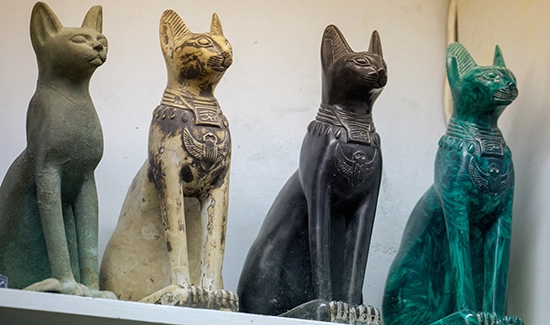Egyptians could have helped spread cats across the ancient world

While ancient Egyptians might not have been the first to domesticate cats, they could be the reason behind the spread of cats across Europe and Asia.
Ancient Egyptian culture and artwork has shown us time and again how popular and revered cats were in their society. For that reason, it was believed for many years that they must have been the first to domesticate cats. However, in 2004, researchers discovered a 9,500-year-old cat buried with human remains on the island of Cyprus.
This new study, published online in June 2017 in the journal of Nature Ecology & Evolution, shows that while Egyptians were not the first to domesticate cats, they likely lent to the popularity of the domestic cat.
The researchers performed ancient DNA analysis from bone, teeth, skin, and hair samples of 352 ancient cat. The cat remains tested covered Europe, north and east Africa, and southwest Asia. Samples spanned about 9,000 years, going back to before 6,500 BCE all the way up to the twentieth century CE.
In addition to domestic cats, researchers tested populations of Felis silvestris lybica, or wildcats, that had contributed to the gene pool of domestic cats at different times in history. The mtDNA phylogeny reconstructed from wild and domestic cats identified five geographically distinct clades.
In Africa, two lineages of clade IV were found—IV-C1 and IV-C*. This strain was detected in five of the seven cats from Egypt, including three of the mummies. The dates on these cats ranged from the seventh century BCE to the fourth century CE. Outside Africa, IV-C1 was found in five Classical Antiquity period cats from Bulgaria, Jordan, and Turkey.
The expansion of cats with this lineage is clear when looking at the progression from 400 CE to 1200 CE, when the two IV-C lineages become more frequent in Europe (seven of nine cats) and southwest Asia (32 of 70 cats).
These changes suggest to the researchers that humans spread cats carrying IV-C haplotypes through the eastern Mediterranean region in Classical antiquity. They write that the “Egyptian cat must have been very popular, as IV-C1 and C* represented more than half of the maternal lineages in Western Anatolia during the 1st millennium AD, and occurred twice as frequently as the local mitotype IV-A*.” The way Egyptians bred cats and developed the human-animal bond could account for this popularity.
Early depictions of cats in ancient Egyptian art often show them in a working setting—hunting rats, for example. But as time went on, those depictions changed to show domesticated cats living near and among people, like the famous depiction of a cat sitting under a woman’s chair from around 1500 BCE.
One other interesting aspect of the study looked at cats’ coat colors to see if human breeding played a hand in how cats looked as they have with dogs. They found that the blotched-tabby pattern does not appear in cats before the Medieval period. This suggests that ancient Egyptians bred cats for personality traits rather than looks.
Based on the results, it is possible at that Egyptians independently domesticated cats a second time, but the genetics do not bear that out clearly. As the researchers conclude, what the study does provide is “answers to longstanding questions concerning the domestication process of the cat and contributes to a better understanding of how humans have reshaped global biodiversity through species translocations.”
In other words, without ancient trade routes and an Egyptian affinity for cats, maybe the domesticated breeds we know today wouldn’t be as widespread as they are.
Photo credit: © iStock/Goddard_Photography



